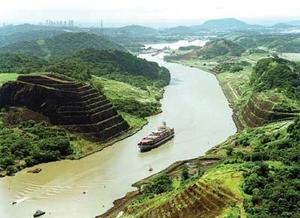InfrastructurePanama Canal is due a big earthquake
The Panama Canal is at greater risk of a catastrophic earthquake than previously assumed, a seismological survey of faults around the canal has warned; the survey estimate that quakes occur every 300 to 900 years. The most recent one was in 1621, so another could happen at any time

An earthquake would devastate international shipping // Source: pressonline.rs
The Panama Canal is at greater risk of a catastrophic earthquake than previously assumed, a seismological survey of faults around the canal has warned. It reveals that two known faults adjacent to the canal are far more active than previously thought, raising the possibility of a major quake just as the canal is being widened and upgraded and upgraded in a project due for completion in 2014.
The authors of the survey estimate that quakes occur every 300 to 900 years. The most recent one was in 1621, so another could happen at any time. Along both faults, surfaces normally rub harmlessly past one another at a rate of around half a centimeter a year. Stresses can build up, however, causing the faults to jump suddenly, say the authors of the survey. The question is by how much.
In the worst case, the ground could shift laterally by up to three meters, says Tom Rockwell of San Diego State University, California, head of the survey team. “That means that any structures built directly on the fault are likely to be damaged or destroyed, as an earthquake of this size will produce very strong ground shaking.”
Andy Coghlan quotes Rockwell to say that the major damage would probably be to buildings in Panama City that are not built to withstand earthquakes. On the canal itself, the major threat is to locks — and if these are damaged there would be no way to control the flow of water, which would severely disrupt shipping. “As for chasms opening up, that’s the stuff of movies,” says Rockwell.
One of the fissures, called the Pedro Miguel fault, actually runs directly underneath the canal but, mercifully, not directly under any locks. The other, the Limon fault, is roughly a northward continuation of the first.
Coghlan writes that by cutting vertical trenches into the ground along the faults, Rockwell and his colleagues were able to see signs of previous quakes from the exposed cross-sections of earth and rock. They corroborated these findings with observations of recent sideward shifts in previously straight surface features, such as streams.
They conclude that there have been at least three major quakes along the faults in the past 1,400 years, the most recent being a large tremor along the Pedro Miguel fault in 1621. Records from that time indicate that this quake shifted by three meters the course of the Camino de Cruces, an old Spanish cobblestone road along which gold was hauled by mules. “Another such earthquake today could have dramatic effects,” says Rockwell.
The researchers estimate that the earliest quake in the region that they could find evidence for was in 455 AD. More worryingly, the evidence suggests that both faults slipped at once in around 700 AD. The researchers warn that this might happen again, perhaps with one setting the other off, which would add to the destruction.
The researchers are advising the Panama Canal Authority, which is overseeing the expansion program and commissioned the survey, to earthquake-proof all canal structures. The same goes for vulnerable buildings and structures in the region’s major cities.
The whole region is earthquake prone because it overlies an area where tectonic plates of Central America and the Caribbean rub against those of South America. Notable recent quakes include the one in Haiti earlier this year and a series of quakes in San Francisco two decades ago.
Other seismologists welcomed identification of the new risks, especially those associated with both faults failing at once. “The study puts forward a convincing argument for them to be linked, and the longer the fault, the larger the potential earthquake magnitude,” says Clark Fenton, a senior lecturer in seismic hazards at Imperial College London.
Fenton says that until the 1992 Landers earthquake in southern California, multi-fault rupture would have been considered unlikely. In that quake, however, no fewer than five adjacent faults set each other off. “Other recent surface-rupturing earthquakes, such as the 1999 Hector Mine quake in southern California, have opened our eyes to the potential for earthquake rupture to cascade from one fault to another,” he says — hence the concern about the “end-to-end” positions of the Panama faults.
Fenton says that the potential damage to Panama City is more concerning than damage to the canal. “As one of the oldest cities in Central America, it has an abundance of heritage buildings that will have very little resistance to strong seismic shaking.”
